Urban Trends: Bringing Dead Spaces to Life
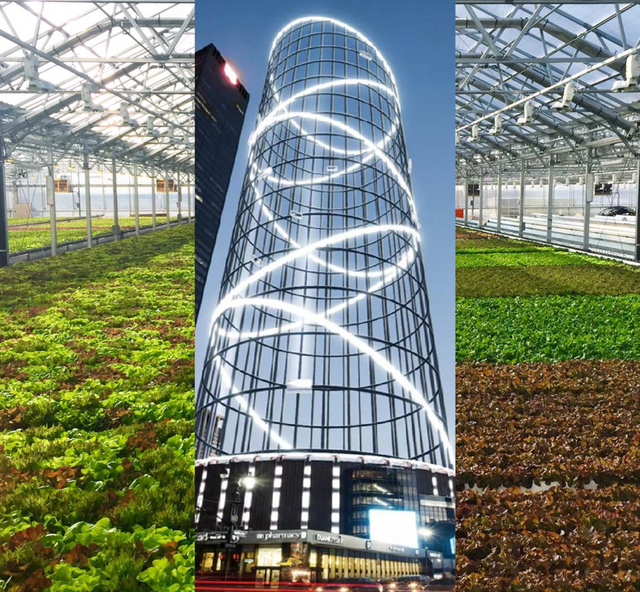
For the last few weeks, I have written a lot of “how to” articles about Steemit, not to mention major parts of the Steemit 101 e-book itself. I’ve even helped other authors and friends by suggesting a few topics to write about, since it’s been so important to help people understand this complex platform with all of its moving parts. Whether they've come from me or others, I hope these “how to” articles and the e-book have been useful to people. For now, I want to write about something lighter that adds value to a different tag here on Steemit.
Recently, I’ve been reading a lot about urban design and some new trends in cities. Green spaces and vertical gardening have always appealed to me. I love the idea of bringing a little country into the city. But I finally realized that something bigger is happening today in cities around the world.
Dead spaces of all sorts are being brought to new life like never before. Urban space all around us is being re-purposed to make it more efficient and more full of life.
Will he or won’t he?

What does this have to do with Steemit? That’s why you read my articles, isn’t it? Sorry, not a darn thing. Can’t an author write about something else once in a while?
Okay, I can’t help myself. Negative spaces in Steemit are disappearing, too. There are so many great new members and amazing posts coming out of the woodwork. They are enlivening these category tags like never before. And the more I understand the economy of Steemit and the interaction of its currencies, rewards, and vesting, the more I think there is very little wasted space here. Every piece has its place. When they all start rocking, they are more than the sum of their parts.
We’re also growing an awesome community!
Living Space
There, I said my Steemit bit. Now let me talk about what’s going on in cities today. I’d like to discuss three trends that are transforming our urban environments in different ways. And yet I feel that these trends are all accomplishing the same thing. They are proving that we finally have come to grips with the dead space in cities. We no longer accept that an old warehouse, factory, rooftop, windowsill, or plain concrete or steel surface must remain the same. And if it won’t be removed or redeveloped, then we’re going to make better use of it, bones and all.
As a society, we are no longer content with a structure or space that subtracts from a city’s productivity, aesthetic, or fun factor. We want to enable life and support it. Some innovations are new, like stronger glass, “supertall” skyscrapers that can be built “superslender”, more efficient and cheaper LED lighting, and gondolas that can freefall at custom speeds. But other innovations harken to the past that we’ve repressed for too long in the face of material progress. These include creating more green spaces, edible gardens, and bee habitats that honor our agrarian heritage. They also include human spaces where people can relax, play, interact, and be nourished by their environment rather than assaulted by it.
In short, we are building better communities, supported by cities which are more efficient and more alive than ever before. Sound familiar? No, I won’t mention the “S......” word. You made the analogy in your own mind and that’s enough. I promised myself I wouldn’t go there, for once.
Trend 1: Vertically Scaring the Crap Out of People and Making Them Pay For It
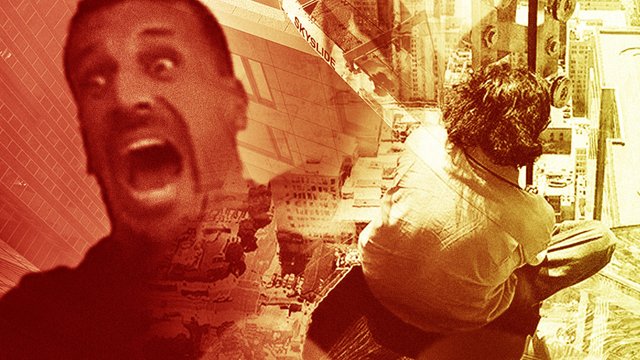
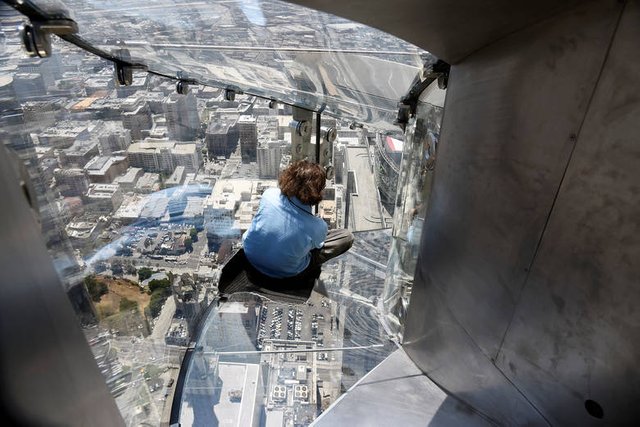
I’m sure you’ve seen the news coverage of this one in recent weeks. 1,000 feet above downtown Los Angeles, the Skyslide recently opened for business. Protected by only 1.25 inches of glass, you can slide down from the 70th to the 69th floor on the outside of the US Bank building, the first “supertall” structure in the western United States.
It costs $33 for an adult to visit the observation deck and ride the SkySlide. While that may seem expensive, a lot of people want to ride it. There will be no shortage of customers, some making a special trip to LA just to experience the thrill.
What a great way to monetize the side of a wall! LA has sky-high property values and rents, but what could this type of attraction do for cities and urban spaces that are struggling to sustain themselves? In 1992, the Baltimore Orioles baseball team opened a new stadium at Camden Yards that incorporated an old warehouse in right field. The retro design was so highly praised that it ushered in a new era of traditional sports stadiums built in downtowns across North America.
Can you imagine a struggling city that long ago lost its manufacturing base deciding to turn an old factory complex into a playground for thrill seekers?
And it’s not just the money. This brings people to a city’s downtown area, where they are likely to dine, shop, and entertain. And it brings a new fun factor to urban spaces. There have been other centerpiece rides in various cities, but the Skyslide example takes things up a notch.
“Amusement park rides are moving into cities"
Soon, you won’t have to go to Los Angeles to experience this type of thrill. Designers are pitching some even bolder ideas to other cities around the world. And the cities are listening, given the vast amounts of money such an attraction would bring in. It’s just a matter of time before we see more adventure thrills in the hearts of the world’s great cities.
In New York City, Grand Central Station is one of the world’s busiest transportation hubs and it also stands as one of the world’s iconic structures. But New York’s Penn Station is a terrible mess. The city would love to completely overhaul Penn Station, but that kind of renovation does not come cheaply in this day and age.
So a development firm is proposing to inject some capital by building a massive free-fall roller coaster atop Penn Station. At 1,200 feet in height, it would cost $35 to ride and feature 11 gondolas with speeds that could be individually adjusted for each rider. The fastest would reach 100 miles per hour in speed by the time they reached the ground in a six-second freefall.
“Amusement park rides are moving into cities,” said the developer, John Gruber of Brooklyn Capital Partners, as quoted in the New York Daily News (link at the bottom of this article). This plan would generate $38 million per year for the transit center project, which is probably more than additional above-ground housing or office space would generate.
Hey Steemit community, how much would we pay to have this interior lighted section display the STEEMIT logo instead of wavy lines?! Wait, they would still be wavy lines, just blue and steemy looking. The STEEM Tower…I can see it now.
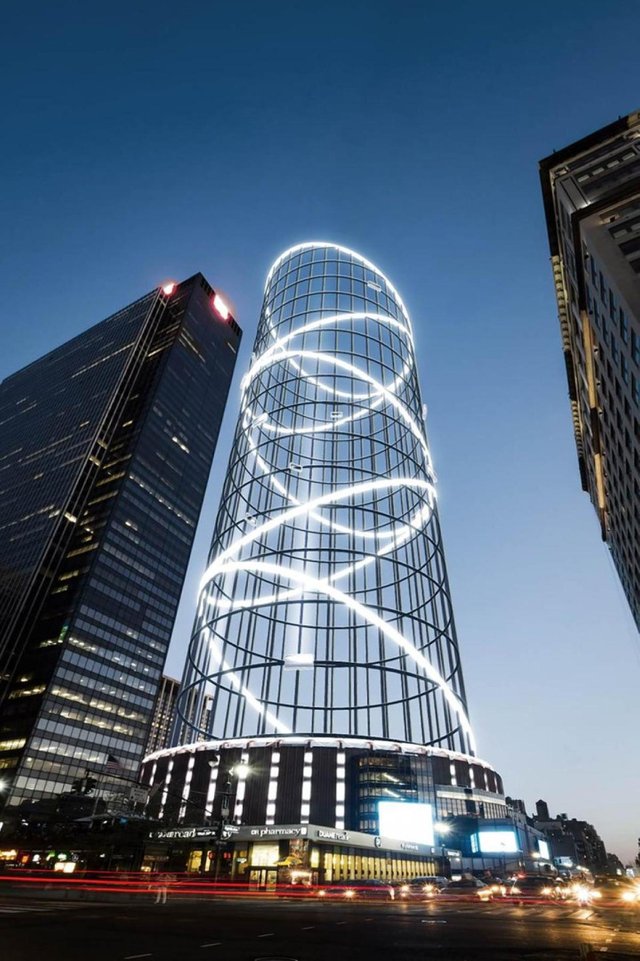
And if it doesn’t happen this time in New York, how about Nashville, Tennessee or Myrtle Beach, South Carolina? Another development company, Thrillcorp, is suggesting that it could build a 600-foot high “Polercoaster” on just half an acre of land in one of those locations. An article in the Tennessean newspaper included the following explanation and quote:
A Polercoaster provides passengers the loops, rolls, dives and speed that a traditional roller coaster offers, plus the thrill of height, the company said in the corporate filing. The structure also allows for ziplines, observation decks and rotating tower-top restaurants.
Here is what the Polercoaster looks like:
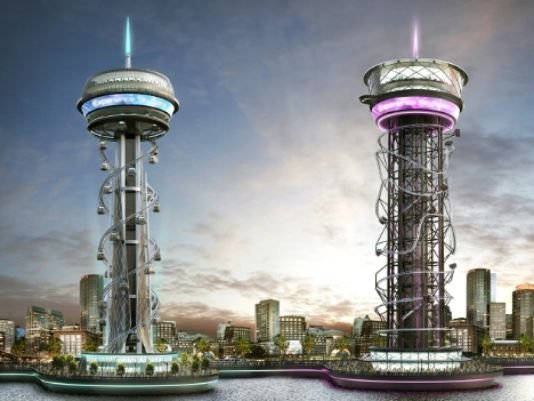
Again, from this article: "We make the best park attractions more thrilling by going taller," Bill Kitchen, Thrillcorp founder, said in a news release. "We put them where people can use them more frequently and at a much lower cost than a theme park. We make it a casual outing as opposed to a full day's commitment. Guests can come out for a few hours, ride a few world-class rides and shop, dine or just stroll. It is a new category of experience." (The link to this source appears at the end of this article.)
When done right, a thrill ride can bring fun and money to a downtown area. More importantly, this can bring life back to sites that have been dead, dull, unused, or ignored for too long. And that’s a good use of space.
Trend 2: P2P Self-Storage Hasn’t Worked Yet, But On-Demand Storage Startups are Booming
Problem: People have too much stuff and cannot fit it in small spaces. But most who live in cities cannot afford larger spaces. And no one wants to hire a moving truck and drive 10 miles just to unearth a tennis racket or an old jacket. Solution: A more responsive model for storing your junk.
The Uberization of storage saw an attempt to monetize unused space by allowing people to get paid for storing other peoples’ stuff. Cubbyhole (not to be confused with Cubby Hole) aimed to create a peer-to-peer sharing network for short-term storage in the Boston area, which has a large student population.
It didn’t go well. Others have tried this elsewhere with limited results. Maybe asking a stranger to store your stuff is too weird. Or maybe they just haven’t solved the transportation part yet. Uber, are you reading this? Can you bring me a pizza while you’re at it?
Enter On-Demand Storage. Fetch and Cubiq are two examples of a more responsive brick-and-mortar model. You don’t need a stranger’s attic; these companies still have the warehouse where your stuff goes. And they help you get your stuff in and out.
The difference with these startups is that they come to you. You need your stuff, they bring it to you “On Demand”. Cubiq has experienced eight-fold customer growth. And part of the reason is probably because of the transportation component in self-storage. Most people living in cities don’t own a truck. Moving stuff, or even getting across town to an industrial area with a storage warehouse, is a real issue for many people.
Ease of self-storage frees up additional urban space for more important uses…like renting out your closet on Airbnb, starting a mushroom farm in your garage, or maybe just more space in which to live. Again, this adds to the efficiency of the urban environment, enabling greater productivity and better living. And once of these days, maybe someone will get the P2P thing right in this field, opening up more closets, garages, basements, and spare rooms.
Trend 3: The Greening of Glass, Steel, and Concrete
This one comes as no big surprise, but it’s a welcome change. The big news is that vertical gardens and green spaces are not just concepts for some futuristic city anymore. They are actually being integrated into real cities in a big way. And it’s pretty neat.
Below is a view of Singapore’s Park Royale on Pickering. While we see many futuristic concept designs for large-scale buildings that integrate gardens and greenspaces, this one really exists. It also is one of the architectural centerpieces of the “Fragments of an Urban Future” display at the 2016 Venice Biennale. There are many other amazing buildings in the works. On a smaller scale, green roofs and green walls have sprouted in cities around the world.
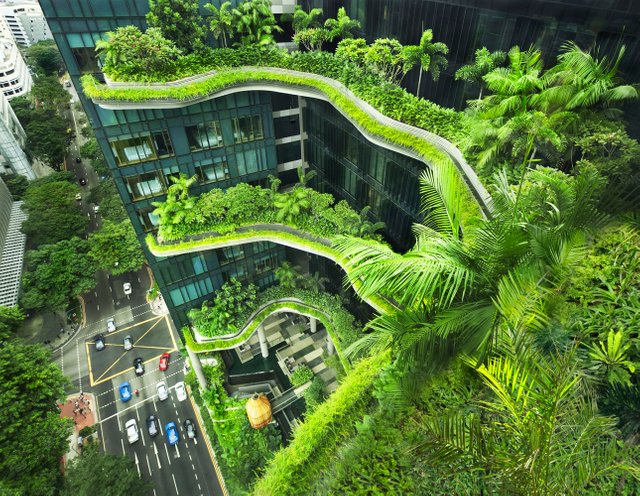
Urban Gardeners Re-Purpose Old Spaces
And you’ve probably seen what urban gardeners and beekeepers are doing in under-utilized spaces, but it bears mentioning. Rooftops, warehouses, shipping containers, and even basements and underground spaces are being transformed into growing areas. LED lighting, which uses far less energy than other earlier forms of growing lights, has made much of this economical in even the darkest or shadiest spots.
While I prefer traditional farms and real soil myself, it is hard to ignore how efficient these urban gardens can be. Modern hydroponic systems use little water, no pesticides, and some of them even have an aquaponics component that uses fish waste in a cycling system. When structured to take advantage of vertical space, they can be far more productive than typical cropland. In addition, when foods are grown for a local urban market, the produce does not need to be stored and trucked and shipped for hundreds or thousands of miles; this saves energy and cuts down on pollution.
With the world’s growing population and the issues of feeding so many hungry mouths, urban gardening appears to be an important part of the solution. And many of its strongest proponents are re-purposing dead spaces to create something new. Something living that also nourishes city life.
In an old bomb shelter tunnel 100 feet beneath the city of London, a company called Growing Underground is doing just that with herbs and greens. They crowdsourced the funds needed to get started.
In Kyoto, a company called Spread is starting a hydroponic farm that soon will be operated by robots. When its whole set of facilities is up and running, the robots will be harvesting 30,000 heads of lettuce per day.
Chicago is quickly becoming a hotbed of urban food farming. Chicago’s City Hall features a rooftop garden including bee hives. It is one of many rooftop gardens in the city. Gotham Greens, a New York company, expanded to Chicago and now operates the world’s largest rooftop greenhouse (pictured below). It’s so huge that it does not really look like a rooftop garden, but the Gotham Greens facility sits on top of a soap factory. Of course it is an environmentally friendly factory, owned by the Method company that makes natural soaps and cleaning products.

Though the spot is not exactly urban, Saudi Arabia is greening the desert with gardens as well. King Abdullah International Garden, under construction near Riyadh, will take on a crescent shape. It will be the world’s largest botanical garden, focusing on plants native to the region and also including a large greenhouse.
Public Green Spaces
We move next to Tokyo, which has few public green spaces. For many years, the main Sony Building in Tokyo’s Ginza district has been an important structure. During the period of Sony’s dominance in electronics, people from all over the world visiting Tokyo would stop to take pictures at the Sony Building. And now it is coming down to make way for a garden, at least temporarily.
The Olympics are coming to town in 2020. And the only real public spaces in Tokyo are shopping areas, most of them indoors. So Tokyo has decided it needs a nice outdoor park. Whether this will stay beyond the Olympics is not known, but at least Japan is acknowledging that the rest of the world expects a public green space.
Seoul is making a similar decision in green-lighting its new Skygarden. This is a city that blends old and new, past and present, but which has paved over almost everything green. Inspired by New York’s High Line, a re-purposed public green space built on an old elevated railway pass, Seoul’s Skygarden will provide the city’s residents with a place to enjoy a splash of nature amid the city’s hustle and bustle.
I hope these cities like their new parks. People in cities deserve more balance. Parks bring life.
Trend XX: Wait, I Thought He Said Just Three Trends!?
Here’s a trend I’d rather not include, but I’ll throw it in as a bonus. In Paris, 19th Century buildings are sprouting trailer parks. And it’s legal there now. Does this bother you? It bothers me. For the record, I don’t care much for this trend, which is defacing neighborhoods that have true character. But who am I to say that people cannot build outwards and add some affordable space in one of the world’s most expensive cities? It also points to a more efficient and cheaper (though ugly) use of our available urban space.
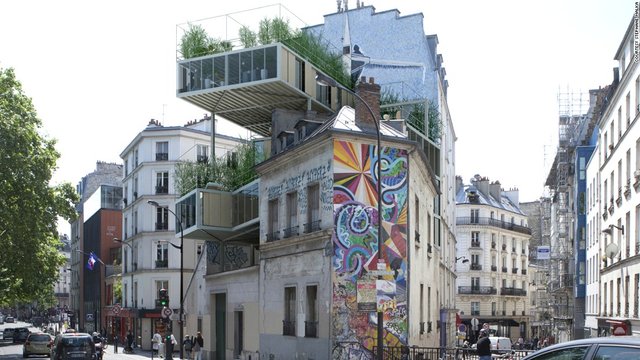
To read more about 19th Century French trailer parks, you can check out the link at the bottom of this article.
Efficiency and a Bit of Nature
Efficiency is good. I think one of the major themes in urban progress is making more productive use of city spaces. But plenty of farms and parkland have been paved over before to make way for “progress” and “efficiency”. What we are seeing now is a more mature human outlook, bringing back a bit of nature and providing more human balance, while also embracing technology that enables better living.
Maybe a dose of nature is just a place to sit with a friend and eat a sandwich for just a few minutes under a green tree. Or it’s a stroll next to a fragrant herb garden in between meetings. Maybe it is a little more breathing room created by outsourcing one’s storage needs to someone who can fetch your stuff whenever you need it. Or maybe it’s a screaming adrenaline rush of a freefall ride down the side of a skyscraper. All of these trends are making our cities more alive.
And now, I’ll go back to upvoting some other peoples’ posts on Steemit. Believe it or not, writing this half-thesis of an article is my idea of a break. I didn’t just start and finish it; this one has taken me a few weeks, off and on. Cheers.
Sources:
Arch Daily on Venice Biennale: http://www.archdaily.com/787229/woha-unveils-fragments-of-an-urban-future-for-the-2016-venice-biennale/5732539ee58ecec4a5000110-woha-unveils-fragments-of-an-urban-future-for-the-2016-venice-biennale-image
More Visions of Vertical Gardening: https://www.inverse.com/article/15580-the-venice-biennale-will-feature-some-amazing-visions-of-vertical-gardening
London’s Underground Farms: http://www.standard.co.uk/lifestyle/esmagazine/how-londons-new-underground-farms-will-revolutionise-the-way-we-source-our-food-a3267221.html
NY Penn Station Ride Proposal: http://www.nydailynews.com/new-york/exclusive-builders-pitch-free-fall-ride-atop-penn-station-article-1.2673775
Nashville Ride Idea: http://www.tennessean.com/story/money/2016/06/30/nashville-makes-short-list-vertical-roller-coaster/86557074/
Self Storage Startups: http://bostinno.streetwise.co/2016/06/29/on-demand-storage-startups-in-boston-cubiq-fetch-sestora/
Japan’s robot lettuce farm: http://www.geek.com/science/japans-first-farm-run-by-robots-will-produce-30000-lettuce-a-day-1646028/
Liberty Park at WTC: http://www.downtownexpress.com/2016/06/30/liberty-park-opens-at-wtc/
Chicago Urban Ag: http://www.alternet.org/food/chicago-becoming-americas-urban-agriculture-capital
Tokyo Sony Olympic Park: https://www.theguardian.com/cities/2016/jun/28/tokyo-sony-flagship-building-olympics-park
Seoul’s Version of a High Line: http://www.wired.com/2015/05/seouls-turning-old-highway-flowery-high-line/
Paris “Trailer Parks”: http://www.cnn.com/2016/06/20/europe/stephane-malka-paris-architecture/
Excellent article. If cities can become funner, greener, healthier places - they'll become more attractive to live.
I'd like to add one more idea to yours. It's one that Barcelona is planning to implement. https://www.theguardian.com/cities/2016/may/17/superblocks-rescue-barcelona-spain-plan-give-streets-back-residents
"Currently faced with excessive pollution and noise levels, the city has come up with a new mobility plan to reduce traffic by 21%. And it comes with something extra: freeing up nearly 60% of streets currently used by cars to turn them into so-called “citizen spaces”. The plan is based around the idea of superilles (superblocks) – mini neighbourhoods around which traffic will flow, and in which spaces will be repurposed to “fill our city with life”, as its tagline says."
The car and roadways dominate and partition cities, with noise, pollution and dangerous fast-moving traffic. If you can take back part of that space for parks and people - we can live in outdoor communities and increase the quality and frequency of our social interactions.
That top floor made out of container looks awesome! The view they must have! Oh and an urban garden on to of it...
Great post by the way! I think it's great to switch styles, even for the reader, giving us the chance to learn about something new everyday :)
LOL! I love that you still manage to tie in an analysis of Steemit in a post "about something lighter that adds value to a different tag here on Steemit" - very creative ;-)
Your whole post is amazing it is definitely filling in a negative space of Steemit. Here's another interesting example of bringing dead spaces to life...the state of Washington is turning a public space in Seattle into an urban food forest for everyone: http://www.npr.org/sections/thesalt/2012/02/29/147668557/seattles-first-urban-food-forest-will-be-free-to-forage